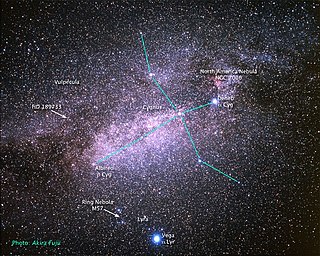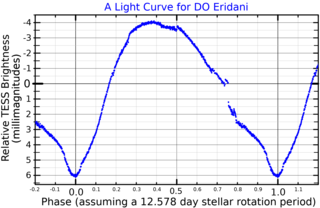
Rho Cassiopeiae is a yellow hypergiant star in the constellation Cassiopeia. It is about 3,400 light-years (1,000 pc) from Earth, yet can still be seen by the naked eye as it is over 300,000 times brighter than the Sun. On average it has an absolute magnitude of −9.5, making it visually one of the most luminous stars known. Its diameter measures between 636 and 981 times that of the Sun, approximately 1,125,000,000 kilometers, or almost four times the size of Earth's orbit.

Epsilon Cancri is a white-hued binary star system in the zodiac constellation of Cancer. It is the brightest member of the Beehive Cluster with an apparent visual magnitude of +6.29, which is near the lower limit of visibility with the naked eye. The annual parallax shift of 5.4 mas as seen from Earth yields a distance estimate of approximately 606 light-years from the Sun.

HD 189733, also catalogued as V452 Vulpeculae, is a binary star system approximately 64.5 light-years away in the constellation of Vulpecula. The primary star is suspected to be an orange dwarf star, while the secondary star is a red dwarf star. Given that this system has the same visual magnitude as HD 209458, it promises much for the study of close transiting extrasolar planets. The star can be found with binoculars 0.3 degrees east of the Dumbbell Nebula (M27).
HD 142 is a wide binary star system in the southern constellation of Phoenix. The main component has a yellow-white hue and is dimly visible to the naked eye with an apparent visual magnitude of 5.7. The system is located at a distance of 85.5 light years from the Sun based on parallax measurements, and is drifting further away with a radial velocity of +6 km/s.

R Carinae is a double star in the southern constellation of Carina. The brighter component is a variable star that can be viewed with the naked eye at peak brightness, but is usually too faint to be seen without a telescope, having an apparent visual magnitude that fluctuates around 7.43. This star is located at a distance of approximately 1,300 light years from the Sun based on parallax, and is drifting further away with a radial velocity of +28 km/s.

S Carinae is a variable star in the constellation Carina.

R Andromedae is a Mira-type variable star in the constellation Andromeda. Its spectral class is type S because it shows absorption bands of zirconium monoxide (ZrO) in its spectrum. It was among the stars found by Paul Merrill to show absorption lines of the unstable element technetium, establishing that nucleosynthesis must be occurring in stars. The SH molecule was found for the first time outside earth in the atmosphere of this star. The star is losing mass due to stellar winds at a rate of 1.09×10−6M☉/yr.

HR 4049, also known as HD 89353 and AG Antliae, is a binary post-asymptotic-giant-branch (post-AGB) star in the constellation Antlia. A very metal-poor star, it is surrounded by a thick unique circumbinary disk enriched in several molecules. With an apparent magnitude of about 5.5, the star can readily be seen under ideal conditions. It is located approximately 1,700 parsecs (5,500 ly) distant.

HR Carinae is a luminous blue variable star located in the constellation Carina. It is surrounded by a vast nebula of ejected nuclear-processed material because this star has a multiple shell expanding atmosphere. This star is among the most luminous stars in the Milky Way. It has very broad emission wings on the Balmer lines, reminiscent from the broad lines observed in the spectra of O and Wolf–Rayet stars. A distance of 5 kpc and a bolometric magnitude of -9.4 put HR Car among the most luminous stars of the galaxy.

V1291 Aquilae is a single star in the equatorial constellation of Aquila. It has a yellow-white hue and is dimly visible to the naked eye with an apparent visual magnitude that fluctuates around 5.65. Based on parallax measurements, it is located at a distance of approximately 278 light years from the Sun. The star it is drifting closer with a radial velocity of −22 km/s.

V529 Andromedae, also known as HD 8801, is a variable star in the constellation of Andromeda. It has a 13th magnitude visual companion star 15" away, which is just a distant star on the same line of sight.

HR 4072 is a binary star system in the northern circumpolar constellation of Ursa Major. It has the variable star designation ET Ursae Majoris, abbreviated ET Uma, while HR 4072 is the system's designation from the Bright Star Catalogue. It has a white hue and is faintly visible to the naked eye with an apparent visual magnitude that fluctuates around 4.94. The system is located at a distance of approximately 339 light years from the Sun based on parallax measurements. The radial velocity measurement is poorly constrained, but it appears to be drifting closer to the Sun at the rate of around −3 km/s.

Y Centauri or Y Cen is a semiregular variable star in the constellation of Centaurus.

UZ Pyxidis is a semiregular variable star in the constellation Pyxis. It is located about 3,600 light-years away from the Earth.
WR 135 is a variable Wolf-Rayet star located around 6,000 light years away from Earth in the constellation of Cygnus, surrounded by a faint bubble nebula blown by the intense radiation and fast wind from the star. It is just over four times the radius of the sun, but due to a temperature of 63,000 K it is 250,000 times as luminous as the sun.

WR 137 is a variable Wolf-Rayet star located around 6,000 light years away from Earth in the constellation of Cygnus.

HD 183143 is a blue hypergiant star located in the constellation of Sagitta.

HD 104237 is a candidate multiple star system in the southern constellation of Chamaeleon. It has the variable star designation DX Chamaeleontis, abbreviated DX Cha; HD 104237 is the stellar designation from the Henry Draper Catalogue. The system is dimly visible to the naked eye with an apparent visual magnitude that ranges from 6.59 down to 6.70. It is located at a distance of approximately 348 light-years from the Sun based on parallax measurements. The system is positioned just 2′ to the north-east of the 5th magnitude star Epsilon Chamaeleontis, and is a member of the ε Cha association of co-moving stars.

RS Sagittarii is an eclipsing binary star system in the southern constellation of Sagittarius, abbreviated RS Sgr. It is a double-lined spectroscopic binary with an orbital period of 2.416 days, indicating that the components are too close to each other to be individually resolved. The system has a combined apparent visual magnitude of 6.01, which is bright enough to be faintly visible to the naked eye. During the primary eclipse the brightness drops to magnitude 6.97, while the secondary eclipse is of magnitude 6.28. The distance to this system is approximately 1,420 light years based on parallax measurements.

HR 1217 is a variable star in the constellation Eridanus. It has the variable star designation DO Eridani, but this seldom appears in the astronomical literature; it is usually called either HR 1217 or HD 24712. At its brightest, HR 1217 has an apparent magnitude of 5.97, making it very faintly visible to the naked eye for an observer with excellent dark-sky conditions.



















